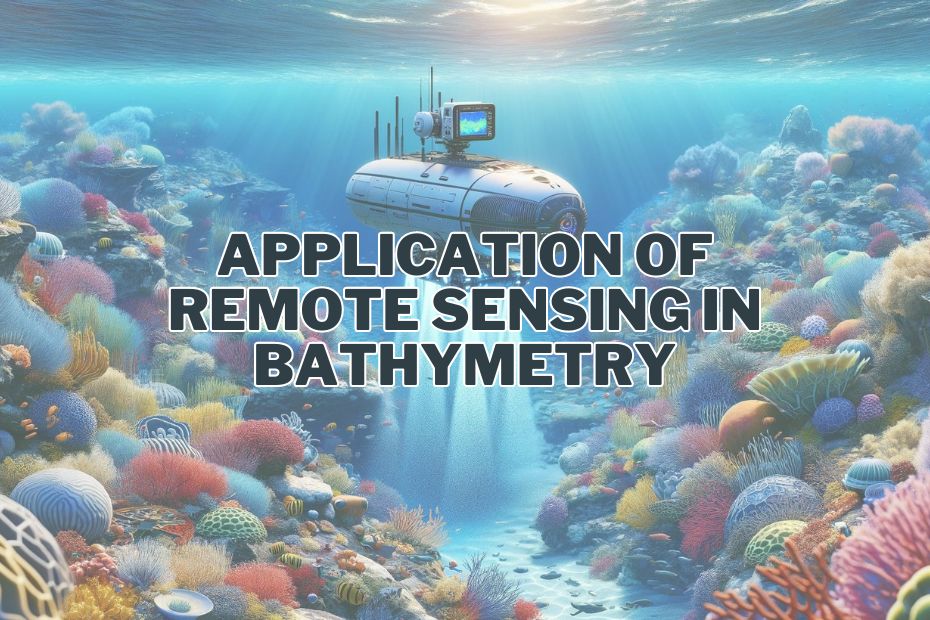The vast and mysterious depths of our oceans and water bodies have always captivated human imagination. Exploring these underwater worlds is not just a matter of curiosity; it’s essential for scientific research, resource management, and environmental conservation. One of the most effective tools in this endeavor is remote sensing. In this article, we’ll dive deep into the application of remote sensing in bathymetry, revealing how technology is helping us unlock the secrets of the deep.
Remote sensing in bathymetry offers a wide array of applications. It aids in coastal zone mapping, marine biodiversity assessment, underwater archaeology, hydrographic surveys, disaster response, and more. Discover how this technology revolutionizes our understanding of underwater environments.
Understanding Bathymetry
Before we delve into the applications, let’s grasp the concept of bathymetry. Bathymetry is the measurement of water depths in oceans, seas, rivers, and lakes. It provides vital information about underwater terrain, which is crucial for various industries and scientific disciplines.
Application of Remote Sensing In Bathymetry
Now, let’s explore how remote sensing is transforming the field of bathymetry:
1. Studying Oceanography
Oceanography, the science of oceans, heavily relies on bathymetric data obtained through remote sensing. Remote sensing technologies, such as sonar and satellite imagery, provide invaluable data about ocean floor topography, underwater ridges, and trenches. This data aids in understanding ocean currents, tides, and marine ecosystems. The detailed maps produced assist in climate change studies by monitoring the rising sea levels and their impact on coastal communities.
2. Mapping Coastal Zones
Remote sensing in bathymetry plays a critical role in mapping coastal zones. It helps in identifying coastal erosion, sediment deposition, and changes in shoreline patterns. Accurate coastal maps are essential for coastal management, protecting ecosystems, and planning coastal development. These maps also assist in predicting the impact of natural disasters like tsunamis, enabling better preparedness and response strategies.
3. Shipwreck Detection
The search for shipwrecks has been revolutionized by remote sensing technologies. Bathymetric data allows researchers to locate sunken ships and aircraft, providing vital clues to historical events and maritime accidents. This technology is not only crucial for archaeological studies but also for salvaging operations and maritime navigation safety.
4. Environmental Monitoring
Remote sensing in bathymetry is integral to environmental monitoring. It aids in assessing the health of marine ecosystems and detecting pollution. By analyzing seafloor composition and topography, scientists can monitor coral reefs, seagrass beds, and other critical habitats. This information is crucial for conservation efforts and in assessing the impact of human activities like fishing, mining, and oil exploration.
5. Marine Biology
In marine biology, bathymetry data enhances our understanding of marine life and habitats. Remote sensing helps in identifying breeding grounds, migration patterns, and biodiversity hotspots. This data is crucial for marine conservation, helping to protect endangered species and maintain the balance of marine ecosystems.
6. Fisheries Management
Effective fisheries management relies on bathymetric data to identify fishing grounds and monitor fish populations. Remote sensing technology helps in sustainable management of fisheries by providing data on fish habitats and migration patterns. This is crucial for maintaining fish stocks and supporting the livelihoods of communities dependent on fishing.
7. Underwater Archaeology
Underwater archaeology benefits from bathymetric remote sensing in locating and studying submerged archaeological sites. This technology provides a non-intrusive way to explore ancient civilizations and trade routes submerged under water. It helps in uncovering historical artifacts and understanding the human past.
8. Pipeline and Cable Inspection
The maintenance of underwater pipelines and cables is another application of bathymetric remote sensing. It allows for the monitoring of these structures, detecting leaks and damages, and ensuring their safe operation. This is vital for communication and energy sectors, as these cables and pipelines are critical infrastructure.
9. Disaster Response and Recovery
In disaster response and recovery, remote sensing in bathymetry is crucial for assessing damage and planning recovery efforts. It helps in mapping affected areas, identifying hazards, and guiding rescue operations. This is particularly important in the aftermath of tsunamis, hurricanes, and other natural disasters.
10. Offshore Energy Exploration
Offshore energy exploration, including oil, gas, and renewable energy sources, benefits from bathymetric data. It aids in identifying potential sites for exploration and assessing environmental impacts. This information is essential for the safe and sustainable extraction of energy resources.
11. Ship Navigation
Ship navigation is greatly enhanced by accurate bathymetric maps. These maps provide information on water depths, underwater obstacles, and safe routes, reducing the risk of maritime accidents. They are essential for the safety and efficiency of maritime transport.
12. Geological Surveys
Geological surveys using bathymetric remote sensing provide insights into the Earth’s structure and geological processes. This data is crucial in studying plate tectonics, volcanic activity, and seismic hazards. It aids in predicting earthquakes and understanding the geological history of the Earth.
Conclusion:
In conclusion, remote sensing has revolutionized bathymetry, enabling us to explore, understand, and protect our underwater world more effectively than ever before. From marine biology to disaster management, the applications of remote sensing in bathymetry are wide-ranging and continue to evolve, promising even greater insights into the depths that cover our planet.
As we navigate the uncharted waters of technology and scientific discovery, one thing is clear: remote sensing is the compass that guides us on this incredible journey of exploration beneath the waves.
FAQs: Application of Remote Sensing In Bathymetry
What is bathymetry?
Bathymetry is the science of measuring and mapping underwater depths and terrain.
How does remote sensing work in bathymetry?
Remote sensing in bathymetry involves using sensors and instruments to collect data from a distance, typically from aircraft or satellites.
What role does bathymetric data play in fisheries management?
Bathymetric data is essential for identifying fishing grounds, monitoring fish populations, and ensuring sustainable management of fisheries, thereby maintaining fish stocks and supporting communities dependent on fishing.
